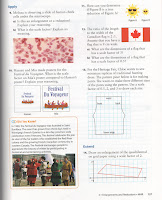Age Problems
When solving age problems, you need to represent the following as a
variable:
- the present ages of the people or things involved
- the age, at the other specified time, of the people or things involved
Then, form an equation based on these representations.
For Example:
Cary is 9 years older than Dan. In 7 years, the sum of their ages will
equal 93.
Find both of their ages now.
- Age Now
- Age Then
- Dan
- x
- x + 7
- Carey
- x+9
- x + 9 + 7
- Sum=93
X= Dan's Age now so X+9 = Cary's Age now
X+7 = Dan's age in 7 years
X+9+7= Cary's age in 7 years
From the question we know that in 7 years, the sum of their ages
will be 93.
We'll use that to write our equation.
So: x+7 + x + 9 + 7 = 93
2x + 23 = 93
2x = 70
x = 35 That is Dan's age now. Because X is Dan's age now.
x+9= 44 That is Cary's age now.
1. Fred is 4 times as old as his niece, Selma. Ten years from now, he
will be twice as old as she will be. How old is each now?
2. An eagle is 4 times as old as a falcon. Three years ago,
the eagle was 7 times as old as the falcon. Find the present
age of each bird.
3. Brenda is 4 years older than Walter, and Carol is twice as old as
Brenda. Three years ago, the sum of their ages was 35. How old
is each now?
4. The present age of Jacob's father is three times that of Jacob. After
5 years, sum of their ages would be 70 years. Find their present ages.
5. After 15 years, Ariel's age will become four times that of her present
age. Find her age.
6. John's mother's age is 5 years more than the three times of John's
present age. Find John's present age, if his mother is 44 years old.
7. The present ages of Derek and Saniya are in the ratio 3:4. Five
years from now, the ratio of their ages will be 4:5. Find their present ages.



















